AMD Athlon 64 X2 6000+: Competing with Aggressive Pricing
by Anand Lal Shimpi on February 20, 2007 3:37 PM EST- Posted in
- CPUs
Media Encoding Performance
Although DivX was one of the first areas we saw performance gains with when moving to 64-bit years ago, our codec and encoding front end are both still 32-bit applications. We've moved to DivX 6.5.1 but our test settings remain the same. We use the codec in its unconstrained profile, using a quality present of 5 in 1-pass mode. Enhanced multithreading is enabled and we report encoding frame rate for our 1080p source file.
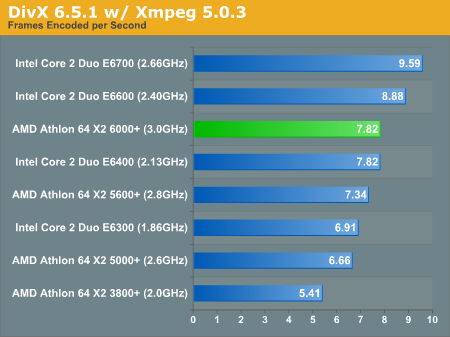
The Core 2 Duo E6700, the closest price competitor to the X2 6000+, delivers significantly better performance in our DivX test. The Core 2's 22% performance advantage more than makes up for its $70 price premium. The E6600 continues the trend by offering better performance at an even closer price to the Athlon 64 X2 5600+. The same is true for the E6400 and the X2 5000+, the clear win goes to the Core 2 processor even when you take into account price.
Windows Media Encoder is available in a 64-bit version and thus we used that here as one of our encoding tests. Our test remains the same as we've run it in the past, only using the 64-bit version of WME instead of the 32-bit version. Performance is reported in frames encoded per second:
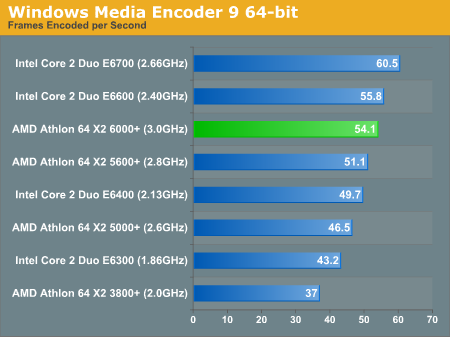
The performance advantages aren't nearly as high as they are under DivX, but our WME tests agree with what we just saw. At equal or similar price points, the Core 2 Duo is a much better performer than the Athlon 64 X2. We've known this to be true ever since the Core 2 launch, but we're re-affirming it after the last round of price cuts.
We also looked at encode time using Windows Movie Maker, a 64-bit application that comes with Windows Vista. We measured the time it took to encode content recorded off of Media Center into a format for posting on YouTube. Encode time was measured in seconds:
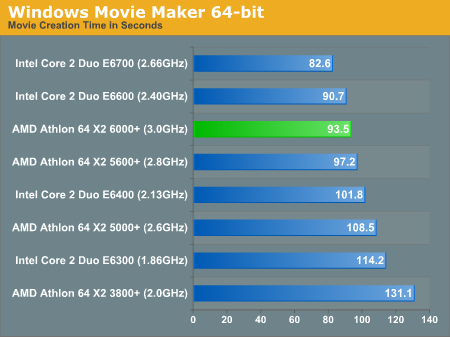
Performance under Windows Movie Maker falls somewhere in between what we saw with DivX and WME; the Core 2 family gets the clean win here.
H.264 encoded content is still not mainstream yet, but the benefits of storing your content in the new format are numerous. We measured H.264 encode performance using Quicktime and report the results in frames encoded per second:
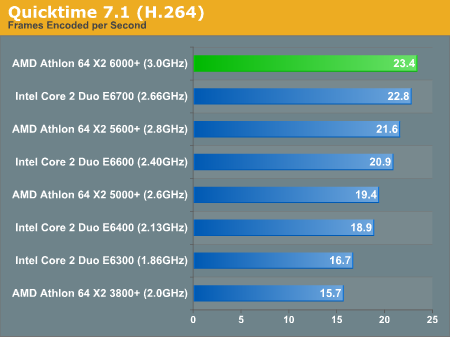
The tables turn a bit under Quicktime, with the Athlon 64 X2 6000+ actually coming out on top. The 5600+ also manages to outperform the E6600 and the 5000+ is faster than the E6400. The results here are a bit different than under Windows XP, but we're unsure of whether that is due to Vista or the 64-bit version of Vista.
We conclude our look at Media Encoding performance with a simple conversion from a 304MB wav file to a 192kbps MP3 using iTunes. The conversion rate is reported in MB/s:
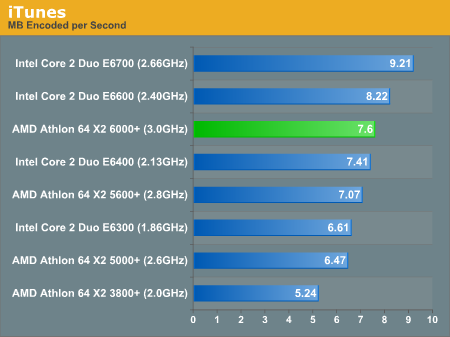
MP3 encoding performance shifts the balance once again over to Intel; the E6700, E6600 and E6400 each hold an advantage over their respective AMD counterparts.










34 Comments
View All Comments
hubajube - Tuesday, February 20, 2007 - link
Wow, no shit? That IS easy.Rolphus - Wednesday, February 21, 2007 - link
You think that's easy...I've got 2.4GHz E6600 on an nForce 680i-based Asus P5N32ESLIWTF board (I forgot the model nubmer, can you tell?).
Last night as I was disabling the onboard audio, in the BIOS, I was curious so I went to the "extreme tweaker" menu, hit "AI Overclock", selected "20% overclock", and there you go - a 2.88GHz E6600.
The machine's fast enough to run everything I want at stock speeds, but who's going to complain about spending 15 seconds to bump the clock speed by 20%?
customcoms - Tuesday, February 20, 2007 - link
I would like to point out that overclocking S939 and AM2 chips is equally easy-and probably why C2D overclocking has proven easy for many people-they started on the AMD chips when they were king and very overclockable (50-60% is not uncommon on the low end AMD chips).For example, my main rig is still an Opteron 165 (basically an X2 3800+ with twice the cache) clocked at 2.7ghz, no voltage change, stock cooling, raised FSB speed from 200 to 300mhz. Required MAYBE 5 bios boots total, all of which were concerned with ram stability (switched ram to 2x1gb at same time installed processor), which can be a pita with a DFI Ultra-D.
The difference between AMD and Intel when it comes to overclocking: highest possible speeds. C2D has A LOT of headroom, which means E6300 AND E6400's can usually reach >3ghz, topping out around 3.5ghz; E6600's can be pushed to 3.7ghz. X2 3800's commonly top out at 2.6gh. Stellar chips can be pushed to 3ghz (actually, good Opty's normally reach 2.8-3ghz, very few X2 3800's get there). No AMD cpu I've seen online has been pushed to 3.2ghz or greater on air. This means C2D is king for now, when we are talking about overclocking.
Neosis - Wednesday, February 21, 2007 - link
You are right about Conroe but actually single core AMD CPUs reached 3200 Mhz with air cooling. And some Opty 165-170-175s managed to exceed 3Ghz Barrier with low voltages. Here is an old thread about San Diego:http://www.xtremesystems.org/forums/showthread.php...">http://www.xtremesystems.org/forums/showthread.php...
neogodless - Tuesday, February 20, 2007 - link
The whole time I was seeing how the X2 6000+ stacked up against the E6600, which would be the CPU I bought if I go with Intel. And suddenly I get to Power Consumption and it's mysteriously absent. I suppose I can try to extrapolate based on the other chips, but if you have data for it and accidentally omitted it, can you please add it in, for the sake of my laziness? Thanks!Imnotrichey - Tuesday, February 20, 2007 - link
i found it interesting the 6700 consumes less power than its younger brothers. But wow, this article made a 6600 really look awesome
JarredWalton - Tuesday, February 20, 2007 - link
Not sure why E6600 is missing on the power charts (perhaps Anand was running a downclocked E6700 for performance testing, which wouldn't be valid in power numbers), but it's pretty safe to say the E6600 would be right around the power draw of the other C2D chips - between the E6700 and E6400. Voltage settings also vary on the C2D CPUs IIRC, so you can get some CPUs that run at 1.1V and others that run at 1.3V, even though they're the same model number.jelifah - Tuesday, February 20, 2007 - link
Is the author making a hint of 'things to come' when Barcelona arrives?A thinly veiled hint that AMD could actually compete? One can only hope. As was said repeatedly in the article, competition is the reason we have these prices and these processors. Without competition I doubt we would be seeing the performance, let alone the price, that we see today
hubajube - Tuesday, February 20, 2007 - link
The X2 5600 does actually compete well with the E6600 and they're very close in price. Although, OCing is another story.goinginstyle - Tuesday, February 20, 2007 - link
I was expecting to see another "just like me" article on this CPU and was surprised to see benchmarks under Vista and 64bit at that. Thanks for an interesting read and hopefully the motherboard editors will start using Vista in their articles now.I still think AMD is close enough in performance that it does not matter that much which platform you use. After all of the troubles I had with my 965 board I wonder why I switched now. Was there any reason why you did not use the nvidia 680i board for testing since the 590 board was used for the AMD system?